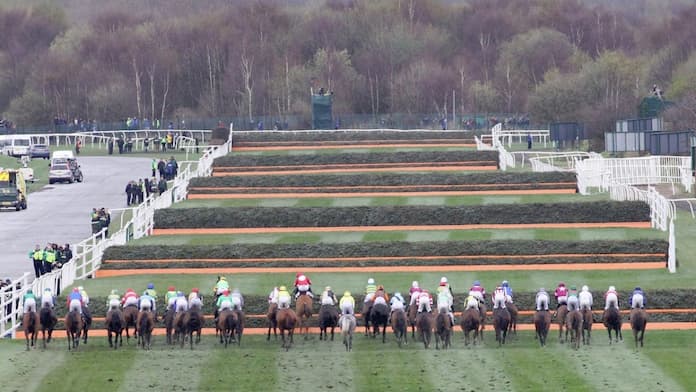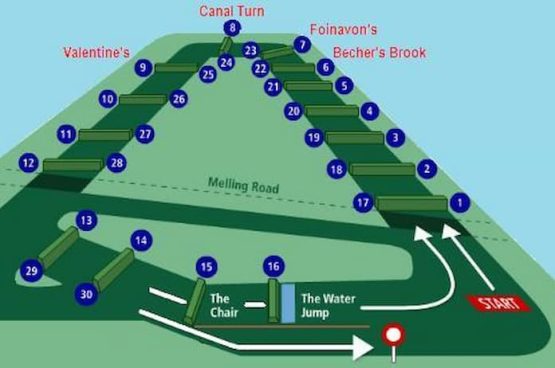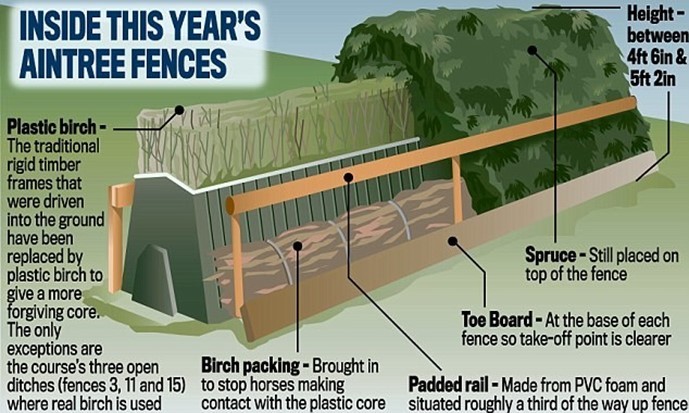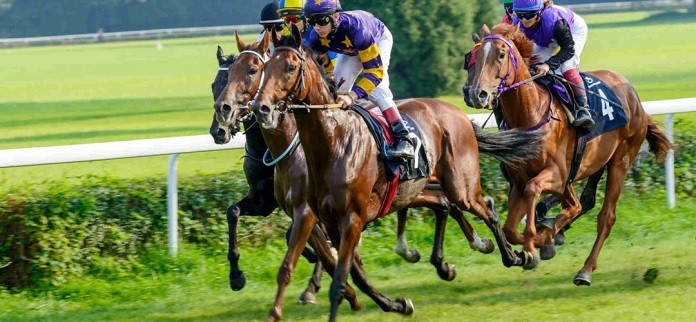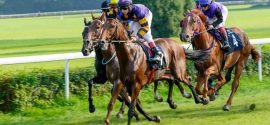As we race towards the biggest horse race on the planet, many people wonder how many Grand National fences the horses have to jump over the 4m 2 1/2f trip.
Over the years some of the Grand National fences have become celebrities in their own right. Obstacles like The Chair, Valentine’s and Becher’s Brook are now household names across the UK.
So, let’s look at how many fences the 40 Grand National runners will tackle, some of the famous names and the order they are jumped.
Grand National Fences Guide
The Grand National was first run in 1839 and over the years the fences and obstacles for the horses to tackle have changed many times. Some have been modified to make them easier, with heights altered and the landing side of others reduced to help lower the risk of fallers.
How Many Grand National Fences Are There?
Over the 4m 2 1/2 furlong trip of the Grand National there 16 fences on the course for the runners to jump. Of these 16 Grand National fences – 14 are jumped twice, so in total there are 30 fences that the winner must negotiated successfully.
Grand National Fences Explained
Fences 1 and 17 (4ft 6in high):
No punter wants to see their horse fall at the first – but it’s often the case we lose at least one early on. Last year, in 2022, Enjoy D’allen didn’t make it over the opening jump – unseating his jockey Conor Orr. That said, the first fence jumped in the Grand National it meant to ease the horses in gently as it’s one of the smallest on the course. Jumped twice during the race.
Fences 2 and 18 (4ft 7in high):
The second fence is just an inch higher than the opening fence, but it’s a lot deeper at 3f 6in so takes a bit more jumping. Jumped twice during the race.
Fences 3 and 19 (5ft high):
The third Grand National fence is the first of three open ditches and at 5f high is taller than the opening two fences. Jumped twice during the race.
Fences 4 and 20 (4ft 10in high):
Slightly lower than the previous fence – jumped twice during the race.
Fences 5 and 21 (5ft high):
This fence was altered back in 2013 with the landing side levelled out. This was to avoid catching horses out with the take-off side higher than the landing side. Jumped twice during the race.
Fences 6 and 22 BECHER’S BROOK (4ft 10in high):
The first of the ‘super-star’ Grand National fences that wouldn’t be out of place on celebrity shows like ‘Love Island or Big Brother’ – if it was a human! Becher’s Brook is a fence that’s talked about the most. Named after Capt. Martin Becher – who, back in 1839, landed in the ditch of this fence in the first Grand National. Jumped twice during the race.
Fences 7 and 23 FOINAVON (4ft 6in high):
Another of the better-known Grand National fences after becoming famous is 1967 after a pile-up at the fence saw the only horse to run it (watch below) – Foinavon. Jumped twice during the race.
Fences 8 and 24 CANAL TURN (5ft high):
Another of the famous Grand National fences – named after the nearby Liverpool-Leeds canal and has a 90-degree left-handed turn straight after it’s jumped – meaning horses tend to try and jump this fence at an angle. Jumped twice.
Fences 9 and 25 VALENTINE’S BROOK (5ft high):
The next big-name fence that has a 5ft 6in brook on the landing side. Named in 1840 after a horse called ‘Valentine’ was meant to have jumped the fence with its hind legs first. Jumped twice during the race.
Fences 10 and 26 (5ft high):
Jumped twice.
Fences 11 and 27 (5ft high):
An open ditch here – become famous in 1935 when the hot Grand National favourite – Golden Miller – fell after refusing to jump the fence. Jumped twice during the race.
Fences 12 and 28 (5ft high):
This next fence has a 5f 6in ditch on the landing side and despite not famous, some more hardened racing fans refer to as the ‘Booth’ – named after former Aintree head maintenance man in the 1970’s. Jumped twice during the race.
Fences 13 and 29 (4ft 7in high):
The 13th (and 29th) fence was modified in 2013, with the landing side smoothed out. Jumped twice during the race.
Fences 14 and 30 (4ft 6in high):
One of the smaller Grand National fences – meant to be an easier fence to jump before tackling the highest fence next – The Chair. Jumped twice during the race.
Fence 15 THE CHAIR (5ft 2in high):
The highest fence in the Grand National and has a 5-foot ditch before the fence too. With a raised landing side it, provides a different test for both horse and jockey. Is only jumped once on the first circuit.
Fence 16 WATER JUMP (2ft 6in high):
Is the final fence on the first circuit and also the lowest of all the fences jumped in the Grand National. The water was introduced in 1841 – replacing a stone wall! Jumped only one on the first circuit.
How Tall Are the Grand National Fences
You can see above the height of the Grand National fences – but they range from the smallest (Water Jump), which is 2ft 6in high, to the tallest Grand National fence – The Chair – which stands at 5f 2in.
The Famous Grand National Fences
The Chair
Is the second last fence jumped on the first circuit and is only jumped once in the race. At 5 foot 2 inches, The Chair is the highest fence jumped in the Grand National. It also has a ditch before the fence – meaning horses must take off well before jumping it. Then with a slightly raised landing side (6 inches) this provides a further test of both jockey and horse.
The Chair got its name as during the early Grand National days a judge would sit near the fence (on a chair) to record the finishing position of the horses. This process ended in 1850, but the area still has a monument where the judges chair once stood. Hence why the fence was originally called the Monument Jump, but became better known as ‘The Chair’ in the 1930’s.
Becher’s Brook
Probably the most famous of all the 16 Grand National fences. At 4f 10 inches it’s one of the higher fences, but with a lower landing side to take off, then it can often catch horses out. The fence also has a left-handed turn on landing, so that combined with the jumping test it provides makes it one of the most thrilling fences to be jumped in the Grand National.
Valentine’s Brook
Is the third of four of the better-known Grand National fences to be jumped in a row. Gained its name in 1840 after a horse called ‘Valentine’ was reported to have somehow jumped the fences with its hind legs first!
Canal Turn
Named after the Leeds/Liverpool canal that runs in front of the horses after they jump the fence. The Canal Turn also has a 90 degree turn after it’s jumped (left-handed). This means the horses often jump the fence at an angle to try and cut the corner and save ground. The Canal Turn fence is jumped twice during the race.
Foinavon
Was a normal fence during the early Grand National years. But become famous overnight in 1967 when 100/1 shot – Foinavon – managed to avoid a mass pile-up at the fence and was the only horse to jump it. The 9 year-old went from last to first after swerving the other horses that failed to jump the fence and went into win the 1967 Grand National at monster odds.
Water Jump
The smallest Grand National fence to be jumped at just 2ft 9in. Is only jumped once (last fence on the first circuit) in the race on the first circuit and being it’s situated in front of the stands, gives the crowd plenty to cheer.
On the final circuit – the Grand National runners bear right (the elbow) to avoid the Chair and Water Jump – to storm up the run in towards the finishing post.
What Is the Elbow On The Grand National Course?
Okay, not a fence – but ‘The Elbow’ is another Aintree track feature that will be mentioned during the Grand National.
The Elbow comes into play right at the end of the race and after the final 30th fence is jumped. It’s around halfway up the long run-in between the last fence and the winning post.
The distance is 494 yards and one of the longest in British horse racing. It’s called the elbow as the horses and riders have to jink right, then left around The Chair to avoid jumping it again.
Meaning the path of the horses after jumping the last looks like an elbow – hence the name.
Many Grand Nationals have been won and lost during ‘The Elbow’ part of the race, with the run-in being so long. One famous example was in Seagram in 1991 – who collared Garrison Savannah, who looked the likely winner after jumping the last 12 lengths clear (see below).
Grand National Course Guide
Related Horse Racing Content:
- Best Horse Racing Free Bets Offers at UK Sportsbooks – Top Horse Racing Bonuses for 2023
- Top Free Horse Racing Tips & Advice for UK Betting Today
- Free Horse Racing Lucky 15 Tips for Today – Best Lucky 15 Bet Today
- Today’s Racecards – View Horse Racing Cards Today
- Horse Racing Results Today – See All Recent Race Results & Winners
- The Best Grand National Betting Sites for 2023
- Grand National Betting Offers 2023 for New and Registered Customers
- When Is The 2023 Grand National? Dates, Times & Aintree Race Schedule
- ITV Horse Racing Schedule For 2023 Grand National Meeting: Aintree ITV Races
- Grand National Runners & Riders 2023 – Guide to All Horses & Weights
- Grand National Odds – Complete Grand National 2023 Odds Guide
- Grand National Tips 2023 – Grand National Tips & Predictions
Add Sportslens to your Google News Feed!
